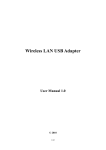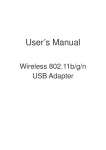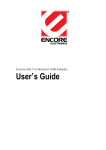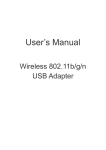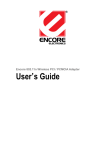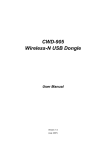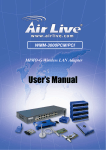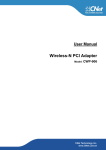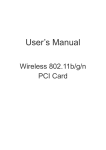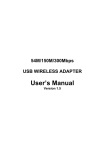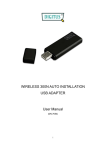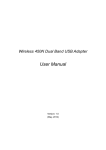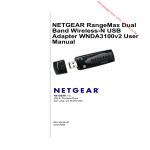Download User`s Manual
Transcript
User’s Manual Wireless 802.11b/g/n Mini-USB Adapter COPYRIGHT Copyright ©2007/2008 by this company. All rights reserved. No part of this publication may be reproduced, transmitted, transcribed, stored in a retrieval system, or translated into any language or computer language, in any form or by any means, electronic, mechanical, magnetic, optical, chemical, manual or otherwise, without the prior written permission of this company This company makes no representations or warranties, either expressed or implied, with respect to the contents hereof and specifically disclaims any warranties, merchantability or fitness for any particular purpose. Any software described in this manual is sold or licensed "as is". Should the programs prove defective following their purchase, the buyer (and not this company, its distributor, or its dealer) assumes the entire cost of all necessary servicing, repair, and any incidental or consequential damages resulting from any defect in the software. Further, this company reserves the right to revise this publication and to make changes from time to time in the contents thereof without obligation to notify any person of such revision or changes. Index Chapter I : Product Information ...........................................................................................................5 1-1 Introduction and safety information ..............................................................................5 1-2 Safety Information .........................................................................................................6 1-3 System Requirements ....................................................................................................7 1-4 Package Contents...........................................................................................................7 1-5 Familiar with your new wireless network card..............................................................8 CHAPTER II : DRIVER INSTALLATION AND CONFIGURATION .............................................9 2-1 Network Card Installation..............................................................................................9 2-2 Connect to Wireless Access Point................................................................................14 2-2-1 Using Ralink Utility .................................................................................................14 2-2-2 Profile .......................................................................................................................18 2-2-2.1 Add/Edit Profile.....................................................................................................20 2-2-2.2 Example to Add Profile in Profile .........................................................................24 2-2-2.3 Pre-logon Connect.................................................................................................26 2-2-3 Network ....................................................................................................................27 2-2-3.1 Example of Adding a Profile to the Network ........................................................29 2-2-4 Advanced ..................................................................................................................31 2-2-4.1 Certificate Management ........................................................................................32 2-2-5 Link Status................................................................................................................33 2-2-5.1 Throughput ............................................................................................................34 2-2-5.2 Statistics.................................................................................................................35 2-2-6 About ........................................................................................................................37 2-2-7 WPS..........................................................................................................................38 2-2-7.1 Example of Adding to Registrar Using PIN Method ............................................40 2-2-7.2 Example of Adding to the Registrar Using the PBC Method................................44 2-2-7.3 Example of Configuring a Network/AP Using PIN or PBC Method....................48 2-3 Security ........................................................................................................................51 2-3-1 Authentication\Encryption Setting - WEP/TKIP/AES.............................................51 2-3-2 802.1x Setting...........................................................................................................53 2-3-3 Example of Configuring a Connection with WEP on ..............................................56 2-3-4 Example to Configure Connection with WPA-PSK.................................................58 2-3-5 Example to Configure Connection with WPA .........................................................60 2-4-1 Using Windows Zero Configuration ........................................................................66 CHAPTER III : AP mode management guide for Windows XP/Vista ..............................................70 3-1.1 Use Ralink soft AP in XP .........................................................................................70 3-1.2 Use Ralink soft AP in Windows Vista ......................................................................71 3-2.1 Start Ralink Soft AP..................................................................................................74 3-2.2 Config AP .................................................................................................................76 3-2.3 Advanced ..................................................................................................................80 3-2.4 Access Control List...................................................................................................81 3-2.5 Associate List............................................................................................................82 3-2.6 About ........................................................................................................................83 CHAPTER IV : APPENDIX..............................................................................................................84 4-1 Hardware Specification ...............................................................................................84 4-2 Troubleshooting ...........................................................................................................85 4-3 Glossary .......................................................................................................................87 4-4 FCC and Other Compliance Statements ......................................................................91 Chapter I : Product Information 1-1 Introduction and safety information Thank you for purchasing this high-speed 802.11b/g/n wireless network card! Excepting common wireless standards 802.11b/g, this wireless network card is also 802.11 n compatible - data transfer rate is 300Mbps, and that’s six times faster than 802.11g wireless network! 802.11 n also provides wider wireless coverage, so you don’t have to worry if your computer is far from your wireless access point. This wireless network card also supports MIMO (Multi-In, Multi-Out) technology, which uses two different radio channels to enhance data transfer rate and wireless coverage. With easy-to-install USB 2.0 interface - a very common expansion port of computers - plug this wireless network card into any empty USB port of your computer, just that simple! Other features of this adapter including: ‧QoS function: Control the bandwidth required for different applications. ‧802.11b/g/n compatible. ‧Supports major encryption methods like WPS, WEP, WPA, and WPA2 encryption. ‧USB 2.0 interface - you can get it installed on your computer in just few seconds! ‧Support Cisco CCX. 1-2 Safety Information In order to keep the safety of users and your properties, please follow the following safety instructions: 1. This USB wireless network card is designed for indoor use only. DO NOT expose this network card to direct sun light, rain, or snow. 2. DO NOT put this network card at or near hot or humid places, like kitchen or bathroom. Also, do not left this wireless network card in the car in summer. 3. This network card is small enough to put in a child’s mouth, and it could cause serious injury or could be fatal. If they throw the network card, the card will be damaged. PLEASE KEEP THIS NETWORK CARD OUT THE REACH OF CHILDREN! 4. This network card will become hot when being used for long time (This is normal and is not a malfunction). DO NOT put the network card on a paper, cloth, or other flammable objects after the network card has been used for a long time. 5. There’s no user-serviceable part inside the network card. If you found that the network card is not working properly, please contact your dealer of purchase and ask for help. DO NOT disassemble the network card by your self, warranty will be void. 6. If the network card falls into water, DO NOT USE IT AGAIN BEFORE YOU SEND THE CARD TO THE DEALER OF PURCHASE FOR INSPECTION. 7. If you smell something strange or even see some smoke coming out from the network card, switch the computer off immediately, and call dealer of purchase for help. 1-3 System Requirements ‧An empty USB 2.0 port (May not work on USB 1.1 port, and performance will be greatly reduced) ‧Windows 2000, 2003, XP, or Vista 32/64, WIN7 operating system ‧CD-ROM drive ‧At least 100MB of available disk space 1-4 Package Contents Before you starting to use this wireless network card, please check if there’s anything missing in the package, and contact your dealer of purchase to claim for missing items: □ USB wireless network card (1 pcs) □ Quick installation guide (1 pcs) □ User manual CD-ROM (1 pcs) 1-5 Familiar with your new wireless network card ‧USB Connector ‧WPS Button : Press this button 3 seconds to auto link to the AP with WPS encryption. ‧Act LED LED Name Light Status Description On Linked to a wireless access point / Transferring data Off No wireless activity Act CHAPTER II : DRIVER INSTALLATION AND CONFIGURATION 2-1 Network Card Installation Please follow the following instructions to install your new wireless network card: 1. Insert the USB wireless network card into an empty USB 2.0 port of your computer when computer is switched on. Never use force to insert the card, if you feel it’s stuck, flip the card over and try again. 2. The following message will appear on your computer, click ‘Cancel’. 3. Insert device driver CD-ROM into the CD/DVD ROM drive of your computer, and install the driver. Choose the Language you want to install and click ‘Next’. 4. Choose the ‘ Install driver and Boulanger WLAN Utility’ or ‘Install driver only’. When you choose ‘Install driver and Boulanger WLAN Utility’, you can choose the configuration tool used to configure the wireless network card here. It’s recommended to select ‘Boulanger Configuration Tool’, which provides fully access to all function of this wireless network card. If you prefer to use the wireless configuration tool provided by Windows XP, please select ‘Microsoft Zero Configuration Tool’, and then click ‘Next’. 5. Click Install to begin the installation. If you want to review or change any of your installation settings, click ‘Back’. Click ‘Cancel’ to exit the wizard. 6. Please wait while the install procedure is running. When you see this message, please click ‘Finish’ to complete the driver installation process. A new icon will appear at lower-right corner of your computer desktop, you can put the mouse cursor on the icon, and the status of wireless card will be displayed as a popup balloon. 7. When you want to configure your wireless connection, please right click on this icon, and a popup menu will appear. You can click ‘Launch Config Utilities’ to start configuration program. If you want to close configuration utility, please click ‘Exit’. 2-2 Connect to Wireless Access Point There are two ways you can configure your wireless network card to connect to wireless access point: using the Ralink configuration utility which comes with wireless card driver, and using built-in windows zero configuration utility. 2-2-1 Using Ralink Utility Please follow the following instructions to use Ralink configuration utility to connect to wireless access point. 1. Right-click the Ralink configuration utility icon located at lower-right corner of computer desktop, and then click ‘Launch Config Utilities’. 2. When starting RaUI, the system will connect to the AP with best signal strength without setting a profile or matching a profile setting. When starting RaUI, it will issue a scan command to a wireless NIC. After two seconds, the AP list will be updated with the results of a BSS list scan. The AP list includes most used fields, such as SSID, network type, channel used, wireless mode, security status and the signal percentage. The arrow icon indicates the connected BSS or IBSS network. 3. There are three sections to the RaUI dialog box. These sections are briefly described as follow. Button Section: Include buttons for selecting the Link Information page, Profile page, Network page, Advanced page, the About button, Radio On/Off button and Help. Function Section: Appears to present information and options related to the button. Link information page Profile page Network page Advanced page About page When starting RaUI, a small Ralink icon appears in the notifications area of the taskbar, as shown in Figure 2-1-15. You can double click it to maximize the dialog box if you selected to close it earlier. You may also use the mouse's right button to close RaUI utility. Additionally, the small icon will change color to reflect current wireless network connection status. The status is shown as follows: : Indicates the connected and signal strength is good. : Indicates the connected and signal strength is normal. : Indicates that it is not yet connected. : Indicates that a wireless NIC can not be detected. : Indicates that the connection and signal strength is weak. 2-2-2 Profile The Profile List keeps a record of your favorite wireless settings at home, office, and other public hot-spots. You can save multiple profiles, and activate the correct one at your preference. Figure 2-2-1 shows the basic profile section. Definition of each field: Profile Name: Name of profile, preset to PROF* (* indicate 1, 2, 3...). SSID: The access point or Ad-hoc name. Network Type: Indicates the networks type, including infrastructure and Ad-Hoc. Authentication: Indicates the authentication mode used. Encryption: Indicates the encryption Type used. Use 802.1x: Shows if the 802.1x feature is used or not. Cannel: Channel in use for Ad-Hoc mode. Power Save Mode: Choose from CAM (Constantly Awake Mode) or Power Saving Mode. Tx Power: Transmitting power, the amount of power used by a radio transceiver to send the signal out. RTS Threshold: Users can adjust the RTS threshold number by sliding the bar or keying in the value directly. Fragment Threshold: The user can adjust the Fragment threshold number by sliding the bar or key in the value directly. Icons and buttons: : Indicates if a connection made from the currently activated profile. : Indicates if the connection has failed on a currently activated profile. : Indicates the network type is infrastructure mode. : Indicates the network type is in Ad-hoc mode. : Indicates if the network is security-enabled. : Click to add a new profile. : Click to edit an existing profile. : Deletes an existing profile. : Import an existing profile. : Export an existing profile. : Activates the selected profile. 2-2-2.1 Add/Edit Profile There are three methods to open the Profile Editor Dialog box. 1.You can open it by clicking the "Add to Profile" button in the Network page. 2.You can open it by clicking the "Add" button in the Profile page. 3.You can open it by clicking the "Edit" button on the Profile page. Icons and buttons: : To the next page. : Back to the previous page. : Cancel button. Profile Name: The user can chose any name for this profile, or use the default name defined by system. SSID: The user can key in the intended SSID name or select one of the available APs from the drop-down list. Network Type: There are two types, infrastructure and 802.11 Ad-hoc mode. Under Ad-hoc mode, user can also choose the preamble type. The available preamble type includes auto and long. In addition, the channel field will be available for setup in Ad-hoc mode. Authentication Type: There are 7 type of authentication modes supported by RaUI. They are Open, Shared, WPA and WPA-PSK, WPA2 and WPA2-PSK, 802.1x, WAPI-PSK, and WAPI-CA. Encryption Type: For Open authentication mode, the selection of available encryption type are None and WEP. For Shared and 802.1x authentication mode, the selection of available encryption is WEP. For WPA, WPA2, WPA-PSK and WPA2-PSK authentication mode, both TKIP and AES encryption is available. For WAPI-PSK and WAPI-CA authentication mode, only SMS4 encryption is available. WEP Key: Only valid when using WEP encryption algorithms. The key must be identical to the AP's key. There are several formats to enter the keys. 1. Hexadecimal - 40bits : 10 Hex characters. 2. Hexadecimal - 128bits : 26 Hex characters. 3. ASCII - 40bits : 5 ASCII characters. 4. ASCII - 128bits : 13 ASCII characters. Pre-shared Key: This is the key shared between the AP and STA. For WPA-PSK and WPA2-PSK authentication mode, this field must be filled with a key between 8 and 32 characters in length. 802.1x Setting: This is introduced in the topic of "802.1x Setting" Power Save Mode: Choose CAM (Constantly Awake Mode) or Power Saving Mode. Channel: Only available for setting under Ad-hoc mode. Users can choose the channel frequency to start their Ad-hoc network. RTS Threshold: User can adjust the RTS threshold number by sliding the bar, or key in the value directly. The default value is 2347. Fragment Threshold: User can adjust the Fragment threshold number by sliding the bar or key in the value directly. The default value is 2346. 2-2-2.2 Example to Add Profile in Profile Click "Add" below the Profile List. The "Add Profile" will appear. Specify a Profile Name. Select an AP from the SSID drop-down list. The AP list from the last Network. Now the profile which the user set appears in the profile list. Click "Activate". Now the profile which the user active will connect to AP. 2-2-2.3 Pre-logon Connect Field definitions: Pre-logon Connect: Use ID and Password in Profile. ** Recommend: You need to restart the computer when using/non-using Pre-logon connection. 2-2-3 Network The system will display the information of local APs from the last scan result as part of the Network section. The Listed information includes the SSID, BSSID, Signal, Channel, Encryption algorithm, Authentication and Network type Definition of each field : SSID: Name of BSS or IBSS network. Network Type: Network type in use, Infrastructure for BSS, Ad-Hoc for IBSS network. Channel: Channel in use. Wireless Mode: AP support wireless mode. It may support 802.11a, 802.11b, 802.11g or 802.11n wireless mode. Security-Enable: Indicates if the AP provides a security-enabled wireless network. Signal: Receive signal strength of the specified network. Connected network : When RaUI first runs, it will select the best AP to connect to automatically. If the user wants to use another AP, they can click "Connect" for the intended AP to make a connection. If the intended network uses encryption other than "Not Use," RaUI will bring up the security page and let the user input the appropriate information to make the connection. Please refer to the example on how to fill in the security information. When you double click an AP, you can see detailed information about that AP. The detailed AP information is divided into three parts. They are General, WPS, CCX information and 802.11n (The 802.11n button only exists for APs supporting N mode.) The introduction is as follows: General information contains the AP's SSID, MAC address, authentication type, and encryption type. 2-2-3.1 Example of Adding a Profile to the Network 1. Select the AP from the list on the Network tab 2. Click "Add to Profile" 3. The System section will appear at the bottom of the Add Profile window. You can specify your own profile name. 4. Next, you will see the new profile in the profile list. Click "Activate" 2-2-4 Advanced 1. Wireless mode: Select wireless mode. 2.4GHz, 5GHz and 2.4GHz+5GHz are supported. 2. Wireless Protection: Users can choose from Auto, On, and Off. (This is not supported by 802.11n adapters.) 2.1. Auto: STA will dynamically change as AP announcement. 2.2. On: The frames are always sent with protection. 2.3. Off: The frames are always sent without protection. 3. TX Rate: Manually select the transfer rate. The default setting is auto. (802.11n wireless cards do not allow the user to select the TX Rate.) 4. Select Your Country Region Code: There are eight countries to choose from in the country channel list. (11a ListBox only shows for 5G adapter.) 5. Apply the above changes. 2-2-4.1 Certificate Management The Certificate Management configuration in this page 2-2-5 Link Status Status : Current connection status. If no connection, if will show Disconnected. Otherwise, the SSID and BSSID will show here. Extra Info : Display link status in use. Channel : Display current channel in use. Authentication : Authentication mode in use. Encryption : Encryption type in use. Network Type : Network type in use. IP Address : IP address about current connection. 2-2-5.1 Throughput Link Speed : Show current transmit rate and receive rate. Throughout : Display transmits and receive throughput in unit of Mbps. Link Quality : Display connection quality based on signal strength and TX/RX packet error rate. Signal Strength 1 : Receive signal strength 1, user can choose to display as percentage or dBm format. Signal Strength 2 : Receive signal strength 2, user can choose to display as percentage or dBm format. Signal Strength 3 : Receive signal strength 3, user can choose to display as percentage or dBm format. 2-2-5.2 Statistics The Statistics page displays detailed counter information based on 802.11 MIB counters. This page translates that MIB counters into a format easier for the user to understand. Transmit Statistics: Frames Transmitted Successfully: Frames successfully sent. Frames Fail To Receive ACK After All Retries: Frames failed transmit after hitting retry limit. RTS Frames Successfully Receive CTS: Successfully receive CTS after sending RTS frame. RTS Frames Fail To Receive CTS: Failed to receive CTS after sending RTS. Frames Retransmitted Successfully: Successfully retransmitted frames numbers. Reset counters to zero. Receive Statistics: Frames Received Successfully: The number of frames successfully received. Frames Received With CRC Error: The number of frames received with a CRC error. Frames Dropped Due To Out-of-Resource: The number of frames dropped due to a resource issue. Duplicate Frames Received: The number of duplicate frames received. Reset all the counters to zero. 2-2-6 About Connect to Ralink's website : Ralink Technology, Corp. Display Configuration Utility, Driver, and EEPROM version information. Display Wireless NIC MAC address. 2-2-7 WPS WPS Configuration: The primary goal of Wi-Fi Protected Setup (Wi-Fi Simple Configuration) is to simplify the security setup and management of Wi-Fi networks. Ralink STA supports the configuration and setup using a PIN configuration method or a PBC configuration method through an internal or external Registrar. WPS AP List: Displays the SSID of the surrounding APs with WPS IE from the last scan result. PBC: Start to add to AP using PBC configuration method. PIN: Start to add to Registrar using PIN configuration method. If STA Registrar, remember that enter PIN Code read from your Enrollee before starting PIN. Auto: Starts to add to AP by using to select the AP automatically in PIN method. PIN Code: The user is required to enter an 8-digit PIN Code into Registrar. When an STA is the Enrollee, you can click "Renew" to re-generate a new PIN Code. Config Mode: The station serving as an Enrollee or an external Registrar. After the user clicks PIN or PBC, please do not rescan within two-minutes of the connection. If you want to abort this setup within the interval, restart PIN/PBC or click "Disconnect" to stop WPS action. Progress Bar: Displays the rate of progress from Start to Connected. Status Bar: Displays the current WPS Status. 2-2-7.1 Example of Adding to Registrar Using PIN Method The user obtains a device password (PIN Code) from the STA and enters the password into the Registrar. Both the Enrollee and the Registrar use PIN Config method for the configuration setup. The following image outlines the process. Select an AP (SSID/BSSID) that STA will join to and Select the "PIN/ numeric code" method. Select "Enrollee" from the Config Mode drop-down list. Enter the PIN Code of the STA into the Registrar when prompted by the Registrar. If you use Microsoft Window Connection Now as an External Registrar, you must start PIN connection at STA first. After that, search out your WPS Device name and MAC address at Microsoft Registrar. Add a new device and enter PIN Code of STA at Microsoft Registrar when prompted. Click "PIN" to enter the PIN The result should appear as the image below. Configure one or more credentials Then connect successfully. The result appear as the following image. Click "Finish" Describe "WPS Status Bar" - "PIN - xxx" as follow: 1. Acceptable PIN Configurations: Start PIN connection - SSID ~> Begin associating to WPS AP ~> Associated to WPS AP ~> Sending EAPOL-Start ~> Received M2 ~> Sending M5 ~> Sending EAP-Rsp (ID) ~> Receive EAP-Req (Start) ~> Sending M1 ~> (Received M2D ~> Sending EAP-Rsp (ACK)) Received M6 ~> Sending M7 ~> ~> Sending M3 ~> Received M4 ~> Received M8 ~> Sending EAP-Rsp(Done) ~> Configured ~> WPS status is disconnected ~> WPS status is connected successfully-SSID 2. WPS configuration doesn't complete after a two-minute connection: WPS EAP process failed. 3. When errors occur within two minutes of connecting, the WPS status bar might report "WPS Eap process failed". Error messages might be: 3.1 Receive EAP with wrong NONCE. 3.2 Receive EAP without integrity. 3.3 Error PIN Code. 4. An inappropriate EAP-FAIL received. 2-2-7.2 Example of Adding to the Registrar Using the PBC Method The PBC method requires the user to press a PBC button on both the Enrollee and the Registrar within a two-minute interval called the Walk Time. If there is only one Registrar in PBC mode, the PBC mode selected is obtained from ID 0x0004, and is found after a complete scan. The Enrollee can then immediately begin running the Registration Protocol. If the Enrollee discovers more than one Registrar in PBC mode, it MUST abort its connection attempt at this scan and continue searching until the two-minute timeout. *Before you press PBC on STA and candidate AP. Make sure all APs aren't PBC mode or APs using PBC mode have left their Walk Time. Select an AP (SSID/BSSID) that STA will join to and Select the "Push-button Configuration" method. Click PBC to start the PBC connection. Push the PBC on AP. The progress bar as shown in the figure below indicates that scanning progress. When one AP is found, join it. Configure and receive one or more credential(s). Then connect successfully. The result will be displayed as it is in the figure below. Describe "WPS Status Bar" - "PBC - xxx" as follow : 1. A successful PBC Configuration : Start PBC connection ~> Scanning AP ~> Begin associating to WPS AP ~> Associated to WPS AP ~> Sending EAPOL-Start ~> Receive EAP-Rsp (Start) ~> Sending M1 ~> Received M4 ~> Sending M5 ~> Sending EAP-Rsp (Done) ~> Received M2 ~> Received M6 ~> Configured ~> Sending EAP-Rsp (ID) ~> Sending M3 ~> Sending M7 ~> WPS status is disconnected ~> WPS status is connected successfully-SSID 2. No PBC AP available : Scanning AP ~> No PBC AP available ~> Scanning AP ~> No PBC AP available ~>... 3. Too Many PBC AP available : Received M8 ~> Scanning AP ~> Too Many PBC AP available ~> Scanning AP ~> Too Many PBC AP available ~>... 4. WPS configuration doesn't complete after two-minute connection: WPS Eap process failed. 5. When Errors occur within two-minutes of establishing a connection, the WPS status bar might report "WPS Eap process failed". Error messages might be: 5.1 Receive EAP with wrong NONCE. 5.2 Receive EAP without integrity. 5.3 An inappropriate EAP-FAIL received. Describe "Multiple PBC session overlaps" as follow : 1. Dual bands: AP1 is a G-Band AP using PBC mode. (ID = 0x0004) AP2 is a A-Band AP using PBC mode. (ID = 0x0004) They have the same UUID-E. STA would regard these two APs as a dual-radio AP and select one band to connect. 2. Different UUID-E : AP1 is a G-Band AP using PBC mode. (ID = 0x0004) AP2 is a G-Band AP using PBC mode. (ID = 0x0004) They have the different UUID-E. STA would regard these two APs as two different APs and wait until only one PBC AP is available. 2-2-7.3 Example of Configuring a Network/AP Using PIN or PBC Method 1. Select an AP (SSID/BSSID) that STA will config and Select the "PIN/ numeric code" method. 2. Select "Registrar" from the Config Mode drop-down list. 3. Enter the PIN Code of the STA into the Registrar when prompted by the Registrar. 4. Enter the details of the credential and change configurations (SSID, Authentication, Encryption and Key) manually if needed. 5. Start PIN or PBC. The following procedures are as similar as section 2-2-7.1 (PIN Enrollee Setup) or section 2-2-7.2(PBC Enrollee Setup), 6. If your AP Enrollee has been configured before the WPS process, the credential you set in advance will be updated to the AP itself. Otherwise, after a successful registration, the AP Enrollee will be re-configured with the new parameters, and the STA Registrar will connect to the AP Enrollee with these new parameters. Describe "WPS Status Bar" - "PIN - xxx" as follow : A successful PIN Configuration : Start PIN connection - SSID ~> Sending EAPOL-Start ~> Receive M3 ~> Begin associating to WPS AP ~> Sending EAP-Rsp (ID) ~> Sending M4 ~> Receive M5 ~> Associated to WPS AP ~> Receive M1 ~> Sending M6 ~> Sending M2 ~> Receive M7 ~> Sending M8 ~> Receive EAP Rsp (Done) ~> disconnected ~> Sending EAP Rsp (ACK) ~> Configured ~> WPS status is WPS status is connected successfully-SSID Describe "WPS Status Bar" - "PBC - xxx" as follow : A successful PBC Configuration : Start PBC connection ~> Associated to WPS AP ~> Scanning AP ~> Begin associating to WPS AP ~> Sending EAPOL-Start ~> Sending EAP-Rsp (ID) ~> Receive M1 ~> Sending M2 ~> Receive M3 ~> Sending M4 ~> Receive M5 ~> Sending M6 ~> Receive M7 ~> Sending M8 ~> Receive EAP Rsp (Done) ~> WPS status is disconnected ~> Sending EAP Rsp (ACK) ~> WPS status is connected successfully-SSID Configured ~> 2-3 Security 2-3-1 Authentication\Encryption Setting - WEP/TKIP/AES 1. Authentication Type: There are 7 authentication modes supported by RaUI. They are open, Shared, WPA and WPA-PSK, WPA2 and WPA2-PSK, 802.1x, WAPI-PSK and WAPI-CA. 2. Encryption Type: For Open authentication mode, the selection of available encryption type are None and WEP. For Shared and 802.1x authentication mode, the selection of available encryption is WEP. For WPA, WPA2, WPA-PSK and WPA2-PSK authentication mode, both TKIP and AES encryption is available. For WAPI-PSK and WAPI-CA authentication mode, only SMS4 encryption is available. 3. 802.1X: This is introduced in the topic of Section 2-3-2. 4. Pre-shared Key: This is the shared key between the AP and STA. If operating in WPA-PSK and WPA2-PSK authentication mode, this field must be filled with a key between 8 and 32 characters in length. 5. WEP Key: Only valid when using WEP encryption algorithm. The key must match the AP's key. There are several formats to enter the keys. 1. Hexadecimal - 40bits: 10 Hex characters. 2. Hexadecimal - 128bits: 32Hex characters. 3. ASCII - 40bits: 5 ASCII characters. 4. ASCII - 128bits: 13 ASCII characters. 2-3-2 802.1x Setting 802.1x is used for authentication of the "WPA" and "WPA2" certificate by the server. Authentication type: 1. PEAP: Protect Extensible Authentication Protocol. PEAP transport securely authenticates data by using tunneling between PEAP clients and an authentication server. PEAP can authenticate wireless LAN clients using only server-side certificates, thus simplifying the implementation and administration of a secure wireless LAN. 2. TLS/Smart Card: Transport Layer Security. Provides for certificate-based and mutual authentication of the client and the network. It relies on client-side and server-side certificates to perform authentication and can be used to dynamically generate user-based and session-based WEP keys to secure subsequent communications between the WLAN client and the access point. 3. TTLS: Tunneled Transport Layer Security. This security method provides for certificate-based, mutual authentication of the client and network through an encrypted channel. Unlike EAP-TLS, EAP-TTLS requires only server-side certificates. 4. EAP-FAST: Flexible Authentication via Secure Tunneling. It was developed by Cisco. Instead of using a certificate, mutual authentication is achieved by means of a PAC (Protected Access Credential) which can be managed dynamically by the authentication server. The PAC can be supplied (distributed one time) to the client either manually or automatically. Manually, it is delivered to the client via disk or a secured network distribution method. Automatically, it is supplied as an in-band, over the air, distribution. For tunnel authentication, only support "Generic Token Card" authentication. 5. LEAP: Light Extensible Authentication Protocol is an EAP authentication type used primarily by Cisco Aironet WLANs. It encrypts data transmissions using dynamically generated WEP keys, and supports mutual authentication. 6. MD5-Challenge: Message Digest Challenge. Challenge is an EAP authentication type that provides base-level EAP support. It provides for only one-way authentication - there is no mutual authentication of wireless client and the network.(Only support XP) Session Resumption: The user can choose "Disable" and "Enable". Tunnel Authentication: 1. Protocol: Tunnel protocol, List information include "EAP-MSCHAP v2", "EAP-TLS/Smart card", "Generic Token Card", "CHAP", "MS-CHAP", "MS-CHAP-V2", "PAP" and "EAP-MD5". 2. Tunnel Identity: Identity for tunnel. 3. Tunnel Password: Password for tunnel. ID \ PASSWORD 1. Authentication ID/Password: The identity, password and domain name for server. Only "EAP-FAST" and "LEAP" authentication can key in domain name. Domain names can be keyed in the blank space. 2. Tunnel ID/Password: Identity and Password for the server. Client Certification Use Client certificate: Client certificate for server authentication. EAP Fast Allow unauthenticated provision mode: During the PAC can be provisioned (distributed one time) to the client automatically. It only supported "Allow unauthenticated provision mode" and use "EAP-MSCHAP v2" authentication to authenticate now. It causes to continue with the establishment of the inner tunnel even though it is made with an unknown server. Use protected authentication credential: Using PAC, the certificate can be provided to the client manually via disk or a secured network distribution method. Server Certification 1. Certificate issuer: Select the server that issues the certificate. 2. Allow intermediate certificates: It must be in the server certificate chain between the server certificate and the server specified in the "certificate issuer must be" field. 3. Server name: Enter an authentication sever root. 2-3-3 Example of Configuring a Connection with WEP on 1. Select an AP with WEP encryption and click "Connect". 2. The Authentication \ Encryption function will appear as below; 3. Enter 1234567890 in the Key#1 Hexadecimal field. This value is same as our intended AP's setting. 4. Click "OK". The dialog box will appear as below; 2-3-4 Example to Configure Connection with WPA-PSK 1. Select the AP with a WPA-PSK authentication mode and click "Connect". 2. Authentication \ Encryption function appears. 3. Select WPA-PSK as the Authentication Type. Select TKIP or AES encryption. Enter the WPA Pre-Shared Key as "12345678". 4. Click "OK". Be careful, if the WPA Pre-Shared Key entered is not correct, you won’t be able to exchange any data frames, even though the AP can be connected. 2-3-5 Example to Configure Connection with WPA 1. Select an AP with WPA authentication mode and click "Connect". 2. The Authentication \Encryption function pop up. (If AP setup security to Both (TKIP + AES), system defines is AES that security is severely.) 3. Click "8021X" and the setting page will appear. 4. Authentication type and setting method : PEAP : 1. Select "PEAP" as the Authentication type from the drop-down list. Key-in "wpatest2" for the identity. "Select "EAP-MSCHAP v2" from the drop-down list for tunnel authentication and key-in the tunnel identity as "wpatest2" and the tunnel password as "test2". These settings are the same as our intended AP's setting. 2. Click to next page. *If you want to disconnect, please click cancel button in Authentication Status function. *In Profile function, show "Profile Name" option only in adding AP to Profile function. 3. If the connection is successful, the dialog will appear as below. TLS / Smart Card : 1. "Select TLS / Smart Card" from the Authentication type drop-down list. TLS only requires the identification to be set as "wpatest2" for server authentication. 2. TLS must use client certification. Click "Client Certification" and select a certification for server authentication. 3. Click to the next page. *If you want to disconnect, please click "Cancel" on the Authentication Status function page. *In Profile function, show "Profile Name" option only in adding AP to Profile function. 4. If it connected successfully, the result will appear as in the image below. TTLS : 1. Select TTLS from the Authentication type drop-down list. Key-in the identity as "wpatest2". Select CHAP for tunnel authentication, and key-in the identity as "wpatest2" and tunnel password as "test2". These settings are the same as our intended AP's setting. 2. Click "OK". The dialog box should appear as the image below. *If you want to disconnect, please click "Cancel" on the Authentication Status function page. *In Profile function, show "Profile Name" option only in adding AP to Profile function. 3. If the connection is successful, the dialog box will appear as the image below. EAP-FAST : 1. Select EAP-FAST from the Authentication type drop-down list. Key-in the identity as "wpatest2" and a domain name into the blank field. The tunnel identity is "wpatest2" and password is "test2". These setting are the same as our intended AP's setting. 2. Click to the next page. 3. If the connection is successful, the dialog box will appear as the image below. *If you want to disconnect, please click "Cancel" on the Authentication Status function page. *In Profile function, show "Profile Name" option only in adding AP to Profile function. 2-4-1 Using Windows Zero Configuration Windows XP has a built-in wireless network configuration utility, called as ‘Windows Zero Configuration’ (WZC). You can also use WZC to configure your wireless network parameter: 1. Right-click Ralink configuration utility icon and select ‘Use Zero Configuration as Configuration utility’. 2. Click ‘Start’ button (should be located at the bottom-left corner of windows desktop), click ‘Control Panel’, then click ‘Network and Internet Connections’ in Control Panel. 3. Click ‘Connect to a network’ under ‘Network Connections’. 4. Right-click ‘Wireless Network Connection’ (it may have a number as suffix if you have more than one wireless network card, please make sure you right-click the ‘Ralink 802.11n Wireless LAN Card’), then select ‘View Available Wireless Networks’. 5. All wireless access points in proximity will be displayed here. If the access point you want to use is not displayed here, please try to move your computer closer to the access point, or you can click ‘Refresh network list’ to rescan access points. Click the access point you want to use if it’s shown, then click ‘Connect’. 6. If the access point is protected by encryption, you have to input its security key or passphrase here. It must match the encryption setting on the access point. If the access point you selected does not use encryption, you’ll not be prompted for security key or passphrase. 7. If you can see ‘Connected’ message, the connection between your computer and wireless access point is successfully established. CHAPTER III : AP mode management guide for Windows XP/Vista 3-1.1 Use Ralink soft AP in XP Windows XP provides WPA support to hotfix Q815485, however, you have to make sure that hotfix Q815485 (requires XP SP1 to be installed) has been installed in your system before you can start using the WPA features. You can check the installation of hotfix in add/remove software page under control panel. Currently, Ralink’s utility (RaConfig) provides WPA-PSK supplicant functionality if the user requires the WPA function. RaConfig will prompt the user to make a selection when it first runs after XP boots. 3-1.2 Use Ralink soft AP in Windows Vista Ralink Soft AP utility needs the Windows AutoConfig service to be enabled in order to work properly. The procedure to start AutoConfig service is as follows. How to Start Windows AutoConfig Service Step 1: Select "Control Panel" from the start menu Step 2: Double-click the "Administrative Tools" icon Step 3: Double-click "Services" Step 4: Double-click "WLAN AutoConfig" Step 5: Manage the settings through the AutoConfig Properties dialog box 3-2.1 Start Ralink Soft AP Clicking will bring up the selection window and let the user make a selection. It can switch between "AP mode" and "Station mode" If "Switch to Station mode" is selected, please refer to the station’s help file. If "Switch to AP mode" is selected, the system will display Main Window. Main window There are six function items to use (Red line area). - Config AP: This item is used to configure basic settings - Advanced : This item is used to configure advanced settings - Access Control List: This item is used to edit the access control lis. - Associate list : This item displays the stations which are currently connected to Soft AP. - About : This item displays the Ralink driver and utility information There are five information text to show (Green line area) - SSID: SoftAP's SSID. - Mode : RF band, 2.4G or 5G. - Channel : Channel number. - IP: IP address. - Mask: Subnet mask. There are three state icons to show (Blue line area). : Indicate radio on : Indicate radio off : Indicate security enabled : Indicate security disabled System Tray Menu When starting Ralink Soft AP utility, a small Ralink icon appears within the notification area of the windows taskbar . Double click it to bring up the main menu if the Ralink Soft AP utility menu was closed earlier. The user can also right-click the Ralink icon to bring up the control menu. There are three actions available. - Launch Config Utilities: Restore Ralink Soft AP utility window - Switch to Station Mode: Switch to Station mode - Exit: End Ralink Soft AP utility The icon changes color to reflect the current wireless network connection status. The status is indicated as follows: :Indicate connected and signal strength is good. :Indicate connected and signal strength is normal. :Indicate connected and signal strength is weak. :Indicate wireless NIC not detected. :Indicate not connected yet. 3-2.2 Config AP User can configure Soft AP basic settings in Config AP Window. You can press next button to configure step by step. First page in Config AP Window First page settings: 1. SSID: SoftAP's name. System default is SoftAP-XX ( XX is last two numbers of MAC address). 2. Hide SSID: Don’t display the AP name. The system default is to not hide the SSID. 3. Wireless Mode: Select wireless mode. 2.4G and 5G are supported. System default is 2.4G. ( 802.11 B/G/N mix selection item only exists for B/G/N adapter ) Second page in Config AP Window Second page settings: 1. Select Country Region: The Country Region Code allows the user to specify the available channel list based on their country's regulations.Country channel list: Country channel list. (11A ListBox only shows for A/B/G adapter.) 2. Channel: Select the AP’s operating channel manually. System default is channel 1. 3. Allow BW40 MHz: Allow BW40 MHz capability. Third page in Config AP Window Third page settings: 1. Authentication: The available authentication mode are Open, Shared, WPA-PSK, WPA2-PSK, and WPA-PSK / WPA2-PSK. 2. Encryption: For Open and Shared systems, the available options are None and WEP. For WPA-PSK and WPA-PSK / WPA2-PSK, the available options are TKIP and AES. For WPA2-PSK, the available options are TKIP, AES, and BOTH. If Authentication type is Open or Shared and Encryption type is WEP, and press next button, you will see the figure as Figure 2-2-4. If Authentication type is WPA-PSK, WPA2-PSK, or WPA-PSK / WPA2-PSK and Encryption type is TKIP, AES, or BOTH, and press next button, you will see the figure as Figure 2-2-5. If Authentication type is Open and Encryption type is Not Use, and press next button, you will finish settings and close Config AP window. Fourth page in Config AP Window Fourth page settings: 1. Default Tx Key: Select Tx key index from 1 to 4. 2. Key Format: Input 10 or 26 characters for WEP Key if select Hex, but input 5 or 13 characters for WEP Key if select ASCII. 3. WEP Key: Input shared secret key between station and AP. Fourth page in Config AP Window Fourth page settings: 1. WPA-PSK Key: Input shared secret key between station and AP. Key length is 8~63 ASCII characters or 64 HEX characters. 2. Group Rekey Interval: AP will update group key per specified interval time. After finish four(or three) page settings, you will exit Config AP window, and return to Main window. Change of settings will be shown in Main window as Figure 2-2-6. Return to Main Window after exit Config AP Window You can use another station and Ralink Wireless Utility (RaUI) to connect SoftAP as following figure. Use RaUI to connect SoftAP 3-2.3 Advanced User can configure Soft AP advanced settings in Advanced Window. Advanced Window 1. No forwarding among wireless clients: If apply this item, packets between wireless clients are not forwarding by Soft AP. The system default is forwarding. 2. Beacon interval (ms): The time span between two successive beacons. System default is 100 ms. 3. TX Power: The transmitting power of Soft AP. System default is 100%. 4. Idle Time: The allowed idle time before proceeding with the authentication. The default is 300. 5. Apply: Apply the above changes. 3-2.4 Access Control List Access Control List Window 1. Access Policy:There are three policies available in the drop-down list. They are Disable, Allow All, and Reject All. System default is disabled. 2. Mac Address: In order to add an entry into the access control list, the user should input the MAC address without "-" in the text box and then click the "Add" button. 3. Access List:Display all Mac Addresses that the user has set. 4. Add:Add the Mac address set by user. 5. Delete:Delete the Mac address set by user. 6. Remove All:Remove all Mac addresses in [Access List]. 7. Apply:Apply the above changes. 3-2.5 Associate List Associate List Window 1. MAC Address:The station's Mac address of the current connection. 2. AID:The association identifier of the clien. 3. Power Saving Mode:Support Power Saving Mode on the currently connected station. 4. Status:The link status of the current connection. (Only 802.11n wireless cards support) 3-2.6 About The About Window displays the wireless card and driver version information. About Window 1. Connects to Ralink’s website : Ralink Technology, Corp. 2. Displays Configuration Utility, Driver and EEPROM version information. 3. Displays Wireless NIC MAC address. CHAPTER IV : APPENDIX 4-1 Hardware Specification Standards: IEEE 802.11b/g/n Interface: USB 2.0 (USB 1.1 Compatible) Frequency Band: 2.4000 ~ 2.4835GHz (Industrial Scientific Medical Band) Data Rate: 11b: 1/2/5.5/11Mbps 11g: 6/9/12/24/36/48/54Mbps 11n (20MHz): MCS0-15, 32 with Half Guard Interval Support (up to 144Mbps) 11n (40MHz): MCS0-15, 32 with Half Guard Interval Support (up to 300Mbps) Securities: WEP 64/128, WPA, WPA2 Cisco CCX V1.0, V2.0 & V3.0 Compliance Antenna: Internal 2 Antennas with Two TX and Two RX Drivers: Windows 2000/XP/2003/Vista/WIN 7 LEDs: Link/Activity Transmit Power: 13dBm ± 2dBm Temperature: 32~131°F (0 ~ 55°C) Humidity: 10-95% (NonCondensing) Certification: FCC, CE 4-2 Troubleshooting If you encounter any problem when you’re using this wireless network card, don’t panic! Before you call your dealer of purchase for help, please check this troubleshooting table, the solution of your problem could be very simple, and you can solve the problem by yourself! Scenario Solution I can’t find any wireless access Click ‘Rescan’ for few more times and see if you can find point / wireless device in ‘Site any wireless access point or wireless device. Survey’ function. Please move closer to any known wireless access point. ‘Ad hoc’ function must be enabled for the wireless device you wish to establish a direct wireless link. Please adjust the position of network card (you may have to move your computer if you’re using a notebook computer) and click ‘Rescan’ button for few more times. If you can find the wireless access point or wireless device you want to connect by doing this, try to move closer to the place where the wireless access point or wireless device is located. Nothing happens when I click Please make sure the wireless network card is inserted ‘Launch config utilities’ into your computer’s USB port. If the Ralink configuration utility’s icon is black, the network card is not detected by your computer. Reboot the computer and try again. Remove the card and insert it into another USB port. Remove the driver and re-install. Contact the dealer of purchase for help. I can not establish connection with a certain wireless access point 1. Click ‘Connect’ for few more times. 2. If the SSID of access point you wish to connect is hidden (nothing displayed in ‘SSID’ field in ‘Site Survey’ function), you have to input correct SSID of the access point you wish to connect. Please contact the owner of access point to ask for correct SSID. 3. You have to input correct passphrase / security key to connect an access point with encryption. Please contact the owner of access point to ask for correct passphrase / security key. 4. The access point you wish to connect only allows network cards with specific MAC address to establish connection. Please go to ‘About’ tab and write the value of ‘Phy_Addess’ down, then present this value to the owner of access point so he / she can add the MAC address of your network card to his / her access point’s list. The network is slow / having problem when transferring large Move closer to the place where access point is located. Enable ‘Wireless Protection’ in ‘Advanced’ tab. files Try a lower TX Rate in ‘Advanced’ tab. Disable ‘Tx Burst’ in ‘Advanced’ tab. Enable ‘WMM’ in ‘QoS’ tab if you need to use multimedia / telephony related applications. Disable ‘WMM – Power Save Enable’ in ‘QoS’ tab. There could be too much people using the same radio channel. Ask the owner of the access point to change the channel number. Please try one or more solutions listed above. 4-3 Glossary 1. What is the IEEE 802.11g standard? 802.11g is the new IEEE standard for high-speed wireless LAN communications that provides for up to 54 Mbps data rate in the 2.4 GHz band. 802.11g is quickly becoming the next mainstream wireless LAN technology for the home, office and public networks. 802.11g defines the use of the same OFDM modulation technique specified in IEEE 802.11a for the 5 GHz frequency band and applies it in the same 2.4 GHz frequency band as IEEE 802.11b. The 802.11g standard requires backward compatibility with 802.11b. The standard specifically calls for: ‧A new physical layer for the 802.11 Medium Access Control (MAC) in the 2.4 GHz frequency band, known as the extended rate PHY (ERP). The ERP adds OFDM as a mandatory new coding scheme for 6, 12 and 24 Mbps (mandatory speeds), and 18, 36, 48 and 54 Mbps (optional speeds). The ERP includes the modulation schemes found in 802.11b including CCK for 11 and 5.5 Mbps and Barker code modulation for 2 and 1 Mbps. ‧A protection mechanism called RTS/CTS that governs how 802.11g devices and 802.11b devices interoperate. 2. What is the IEEE 802.11b standard? The IEEE 802.11b Wireless LAN standard subcommittee, which formulates the standard for the industry. The objective is to enable wireless LAN hardware from different manufactures to communicate. 3. What does IEEE 802.11 feature support? The product supports the following IEEE 802.11 functions: ‧CSMA/CA plus Acknowledge Protocol ‧Multi-Channel Roaming ‧Automatic Rate Selection ‧RTS/CTS Feature ‧Fragmentation ‧Power Management 4. What is Ad-hoc? An Ad-hoc integrated wireless LAN is a group of computers, each has a Wireless LAN card, Connected as an independent wireless LAN. Ad hoc wireless LAN is applicable at a departmental scale for a branch or SOHO operation. 5. What is Infrastructure? An integrated wireless and wireless and wired LAN is called an Infrastructure configuration. Infrastructure is applicable to enterprise scale for wireless access to central database, or wireless application for mobile workers. 6. What is BSS ID? A specific Ad hoc LAN is called a Basic Service Set (BSS). Computers in a BSS must be configured with the same BSS ID. 7. What is WEP? WEP is Wired Equivalent Privacy, a data privacy mechanism based on a 40 bit shared key algorithm, as described in the IEEE 802 .11 standard. 8. What is TKIP? TKIP is a quick-fix method to quickly overcome the inherent weaknesses in WEP security, especially the reuse of encryption keys. TKIP is involved in the IEEE 802.11i WLAN security standard, and the specification might be officially released by early 2003. 9. What is AES? AES (Advanced Encryption Standard), a chip-based security, has been developed to ensure the highest degree of security and authenticity for digital information, wherever and however communicated or stored, while making more efficient use of hardware and/or software than previous encryption standards. It is also included in IEEE 802.11i standard. Compare with AES, TKIP is a temporary protocol for replacing WEP security until manufacturers implement AES at the hardware level. 10. Can Wireless products support printer sharing? Wireless products perform the same function as LAN products. Therefore, Wireless products can work with Netware, Windows 2000, or other LAN operating systems to support printer or file sharing. 11. Would the information be intercepted while transmitting on air? WLAN features two-fold protection in security. On the hardware side, as with Direct Sequence Spread Spectrum technology, it has the inherent security feature of scrambling. On the software side, WLAN series offer the encryption function (WEP) to enhance security and Access Control. Users can set it up depending upon their needs. 12. What is DSSS? What is FHSS? And what are their differences? Frequency-hopping spread-spectrum (FHSS) uses a narrowband carrier that changes frequency in a pattern that is known to both transmitter and receiver. Properly synchronized, the net effect is to maintain a single logical channel. To an unintended receiver, FHSS appears to be short-duration impulse noise. Direct-sequence spread-spectrum (DSSS) generates a redundant bit pattern for each bit to be transmitted. This bit pattern is called a chip (or chipping code). The longer the chip is, the greater the probability that the original data can be recovered. Even if one or more bits in the chip are damaged during transmission, statistical techniques embedded in the radio can recover the original data without-the need for retransmission. To an unintended receiver, DSSS appears as low power wideband noise and is rejected (ignored) by most narrowband receivers. 13. What is Spread Spectrum? Spread Spectrum technology is a wideband radio frequency technique developed by the military for use in reliable, secure, mission-critical communication systems. It is designed to trade off bandwidth efficiency for reliability, integrity, and security. In other words, more bandwidth is consumed than in the case of narrowband transmission, but the trade off produces a signal that is, in effect, louder and thus easier to detect, provided that the receiver knows the parameters of the spread-spectrum signal being broadcast. If a receiver is not tuned to the right frequency, a spread –spectrum signal looks like background noise. There are two main alternatives, Direct Sequence Spread Spectrum (DSSS) and Frequency Hopping Spread Spectrum (FHSS). 14. What is WMM? Wi-Fi Multimedia (WMM), a group of features for wireless networks that improve the user experience for audio, video and voice applications. WMM is based on a subset of the IEEE 802.11e WLAN QoS draft standard. WMM adds prioritized capabilities to Wi-Fi networks and optimizes their performance when multiple concurring applications, each with different latency and throughput requirements, compete for network resources. By using WMM, end-user satisfaction is maintained in a wider variety of environments and traffic conditions. WMM makes it possible for home network users and enterprise network managers to decide which data streams are most important and assign them a higher traffic priority. 15. What is WMM Power Save? WMM Power Save is a set of features for Wi-Fi networks that increase the efficiency and flexibility of data transmission in order to conserve power. WMM Power Save has been optimized for mobile devices running latency-sensitive applications such as voice, audio, or video, but can benefit any Wi-Fi device. WMM Power Save uses mechanisms included in the IEEE 802.11e standard and is an enhancement of IEEE 802.11 legacy power save. With WMM Power Save, the same amount of data can be transmitted in a shorter time while allowing the Wi-Fi device to remain longer in a low-power “dozing” state. 16. What is GI? GI stands for Guard Interval. It’s a measure to protect wireless devices from cross- interference. If there are two wireless devices using the same or near channel, and they are close enough, radio interference will occur and reduce the radio resource usability. 17. What is STBC? STBC stands for Space-Time Block Coding, which is a technique used to transfer multiple copies of data by multiple antenna, to improve data transfer performance. By using multiple antennas, not only data transfer rate is improved, but also the wireless stability. 18. What is WPS? WPS stands for Wi-Fi Protected Setup. It provides a simple way to establish unencrypted or encrypted connections between wireless clients and access point automatically. User can press a software or hardware button to activate WPS function, and WPS-compatible wireless clients and access point will establish connection by themselves. There are two types of WPS: PBC (Push-Button Configuration) and PIN code. 4-4 FCC and Other Compliance Statements Federal Communication Commission Interference Statement This equipment has been tested and found to comply with the limits for a Class B digital device, pursuant to Part 15 of FCC Rules. These limits are designed to provide reasonable protection against harmful interference in a residential installation. This equipment generates, uses, and can radiate radio frequency energy and, if not installed and used in accordance with the instructions, may cause harmful interference to radio communications. However, there is no guarantee that interference will not occur in a particular installation. If this equipment does cause harmful interference to radio or television reception, which can be determined by turning the equipment off and on, the user is encouraged to try to correct the interference by one or more of the following measures: 1. Reorient or relocate the receiving antenna. 2. Increase the separation between the equipment and receiver. 3. Connect the equipment into an outlet on a circuit different from that to which the receiver is connected. 4. Consult the dealer or an experienced radio technician for help. FCC Caution This device and its antenna must not be co-located or operating in conjunction with any other antenna or transmitter. This device complies with Part 15 of the FCC Rules. Operation is subject to the following two conditions: (1) this device may not cause harmful interference, and (2) this device must accept any interference received, including interference that may cause undesired operation. Any changes or modifications not expressly approved by the party responsible for compliance could void the authority to operate equipment. Federal Communication Commission (FCC) Radiation Exposure Statement This equipment complies with FCC radiation exposure set forth for an uncontrolled environment. In order to avoid the possibility of exceeding the FCC radio frequency exposure limits, human proximity to the antenna shall not be less than 20cm (8 inches) during normal operation. The antenna(s) used for this transmitter must not be co-located or operating in conjunction with any other antenna or transmitter. R&TTE Compliance Statement This equipment complies with all the requirements of DIRECTIVE 1999/5/EC OF THE EUROPEAN PARLIAMENT AND THE COUNCIL of March 9, 1999 on radio equipment and telecommunication terminal Equipment and the mutual recognition of their conformity (R&TTE) The R&TTE Directive repeals and replaces in the directive 98/13/EEC (Telecommunications Terminal Equipment and Satellite Earth Station Equipment) As of April 8, 2000. Safety This equipment is designed with the utmost care for the safety of those who install and use it. However, special attention must be paid to the dangers of electric shock and static electricity when working with electrical equipment. All guidelines of this and of the computer manufacture must therefore be allowed at all times to ensure the safe use of the equipment. EU Countries Intended for Use The ETSI version of this device is intended for home and office use in Austria, Belgium, Denmark, Finland, France, Germany, Greece, Ireland, Italy, Luxembourg, the Netherlands, Portugal, Spain, Sweden, and the United Kingdom. The ETSI version of this device is also authorized for use in EFTA member states: Iceland, Liechtenstein, Norway, and Switzerland. EU Countries Not intended for use None.




























































































